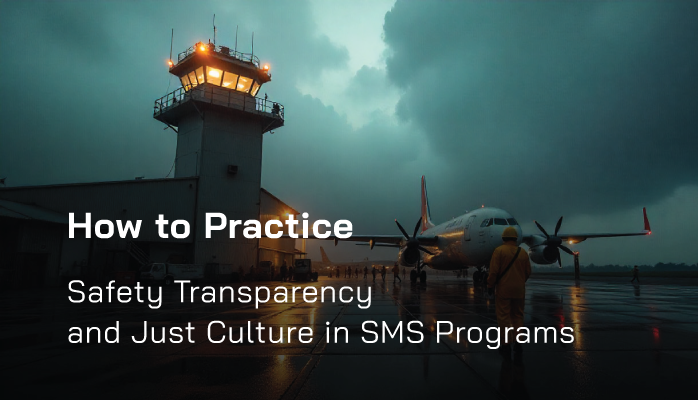What Is Just Culture in Aviation SMS Programs

In layman's terms, Just Culture in aviation SMS programs is an organization’s commitment to focusing on learning and improving in the light of unsafe acts, as opposed to blaming and punishing.
In many ways, just culture is a commitment that is as much documentation and policy as it is actions on the part of management. In many ways, it means taking a scientific approach to understanding the mechanisms of safety incidents.
Your safety policy should include several documents that are ripe with Just Culture overtones, such as a safety manifesto, non-punitive reporting policy, and other documents discussed below.
What Is Safety Transparency Aviation SMS Programs
Safety transparency in aviation SMS programs, simply put, is a top-down stance on how much information various levels of authority should have access to. Safety transparency is not a black-and-white, all-or-nothing thing – there are gradients and levels of safety culture.
Contrary to the message you might commonly see in literature and other resources on transparency, absolute transparency is not necessarily a good idea. Different organizations will benefit from different levels of transparency.
For example, in organizations with very mature safety cultures and well-established safety programs, having a high level of transparency is a beneficial goal to shoot for. For new programs, practicing a limited variation for safety transparency can be an effective tool for slowly building a safety culture.
Note that there are detrimental ways and productive ways to practice low levels of transparency.
Related Aviation SMS Transparency Articles
- A Key to Transparency in Aviation SMS
- How to Write SMS Commitments for Accountable Executives in Aviation
- Overcoming Resistance to Change Through Transparency in Aviation SMS
How to Practice Just Culture in Safety Programs
Just Culture is easier said than done, in the messiness of the real world, practicing Just Culture is more complicated, and more delicate. Here are several best practices for Just Culture:
- Having and regularly distributing a non-punitive reporting policy;
- Regularly publishing safety promotional material that reinforces the non-punitive policy;
- Offering confidential reporting, which is a requirement in some oversight agencies;
- Have clear policies regarding grounds for punitive actions;
- Have clear policies for “acceptable” behavior;
- Distribute policy for mandatory and voluntary issues to report;
- Encourage reporters after they report safety issues; and
- Take extra precaution to focus on the incident and actions rather than the people, such as by referring to people involved in safety issues in the third person.
Practicing High Level of Transparency

High level of transparency is the marker of a very mature safety culture. The four markers of high transparency are:
- All employees can review non-confidential issues that other employees have reported;
- Actions taken on safety issues during issue management are published for employees to see;
- Employees can easily access data regarding the safety performance of the SMS program, such as charts and data analysis; and
- Strong feedback systems, such as via safety surveys, with results posted publicly.
Practicing Moderate Level of Transparency
A moderate level of transparency is a strategy many aviation SMS programs adopt. The four markers of moderate transparency are:
- Employees can review non-confidential issues for their department
- Employees can review actions taken on issues that they have reported, and may or may not review actions taken on issues in their department;
- Employees can easily access data regarding the safety performance of the department, and perhaps of the SMS program as well; and
- Strong feedback systems, such as safety surveys, and employees may or may not be able to see public results.
Practicing Low Level of Transparency
A low level of transparency is also a common strategy aviation SMS programs adopt in order to ensure that employees feel comfortable reporting safety issues. The four markers of low levels of transparency are:
- Employees can only review issues that they submitted, and review desensitized descriptions of other issues that management has approved to release to the public;
- Employees can review actions taken on issues that they have submitted;
- Employees can access safety data that management releases and communicates; and
- Strong feedback system, but employees cannot see public results.
Low transparency can be an effective strategy to maintain a positive reporting culture. Ideally, organizations will use this as a starting point and try and reach for a moderate level of transparency.
What to Avoid When Practicing Low Level of Transparency
As said, practicing low levels of transparency can be an effective strategy. However, there are several pitfalls to avoid:
- Lack of a strong feedback system can make the safety program seem like a “management thing”;
- Not allowing employees to review actions taken on safety issues that they report can hurt confidence that their reported issues “matter”; and
- Not releasing desensitized information about safety issues will cut employees off from important safety information, effectively distancing them from the safety program.
Review these non-punitive reporting policies and verify that you are maximizing the use of your safety policies.
Last updated September 2025.





